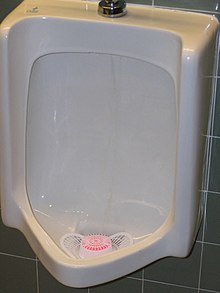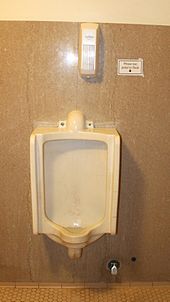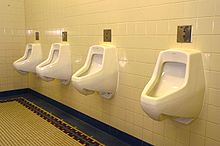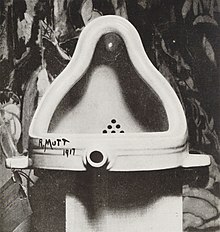Urinal: Difference between revisions
ClueBot NG (talk | contribs) m Reverting possible vandalism by 74.90.189.4 to version by Bearcat. False positive? Report it. Thanks, ClueBot NG. (978403) (Bot) |
manually reverting edit by 173.61.58.74 (talk) (unexplained removal of content) |
||
| Line 3: | Line 3: | ||
A '''urinal''' is a specialized [[toilet]] for [[urination|urinating]] into. It has the form of a container or simply a wall, with drainage and automatic or manual flushing. |
A '''urinal''' is a specialized [[toilet]] for [[urination|urinating]] into. It has the form of a container or simply a wall, with drainage and automatic or manual flushing. |
||
Whilst generally intended for use by males, it is also possible for females to use urinals. The different types of male urinal, for single or multiple users in trough style designs, are intended to be utilised from a standing position. Female urinal design have adopted various approaches - some intending the user to "hover" over the unit, facing away from it, others intending the user to face the urinal, with or without a [[female urination device]]. Whilst uncommon due to restroom designations. |
Whilst generally intended for use by males, it is also possible for females to use urinals. The different types of male urinal, for single or multiple users in trough style designs, are intended to be utilised from a standing position. Female urinal design have adopted various approaches - some intending the user to "hover" over the unit, facing away from it, others intending the user to face the urinal, with or without a [[female urination device]]. Whilst uncommon due to restroom designations, it is possible for females to use male urinals<ref name="restroomsdotorg">{{cite web|url=http://restrooms.org/standing.html |title=http://web.archive.org/web/20030604104917/http://restrooms.org/standing.html |archiveurl = http://web.archive.org/web/20030604104917/http://restrooms.org/standing.html |archivedate = 2003-06-04}}</ref> (and vice versa). |
||
Public urinals often contain a deodorizing [[urinal deodorizer block]] contained within a plastic mesh guard container or a plastic mesh guard without a urinal cake. The plastic mesh guard is designed to prevent solid objects (such as [[cigarette]] butts, feces, chewing gum, or paper) from being flushed and possibly causing a plumbing stoppage. In some restaurants, bars, and clubs, excess ice may be put in the urinals, and serves some of the same purposes as the deodorizing block. This is especially common in South Africa. |
Public urinals often contain a deodorizing [[urinal deodorizer block]] contained within a plastic mesh guard container or a plastic mesh guard without a urinal cake. The plastic mesh guard is designed to prevent solid objects (such as [[cigarette]] butts, feces, chewing gum, or paper) from being flushed and possibly causing a plumbing stoppage. In some restaurants, bars, and clubs, excess ice may be put in the urinals, and serves some of the same purposes as the deodorizing block. This is especially common in South Africa. |
||
Revision as of 22:29, 7 April 2012

A urinal is a specialized toilet for urinating into. It has the form of a container or simply a wall, with drainage and automatic or manual flushing.
Whilst generally intended for use by males, it is also possible for females to use urinals. The different types of male urinal, for single or multiple users in trough style designs, are intended to be utilised from a standing position. Female urinal design have adopted various approaches - some intending the user to "hover" over the unit, facing away from it, others intending the user to face the urinal, with or without a female urination device. Whilst uncommon due to restroom designations, it is possible for females to use male urinals[1] (and vice versa).
Public urinals often contain a deodorizing urinal deodorizer block contained within a plastic mesh guard container or a plastic mesh guard without a urinal cake. The plastic mesh guard is designed to prevent solid objects (such as cigarette butts, feces, chewing gum, or paper) from being flushed and possibly causing a plumbing stoppage. In some restaurants, bars, and clubs, excess ice may be put in the urinals, and serves some of the same purposes as the deodorizing block. This is especially common in South Africa.
The term may also apply to a small building or other structure, in which such toilets are contained. It can also refer to a small container where urine can be collected for medical purposes, or for use where access to toilet facilities is not possible, such as in small aircraft or for the bedridden.
Purposes
In busy men's washrooms, urinals are installed for efficiency: compared with urination in a general toilet, usage is faster because within the room there are no additional doors, no locks, and no seat to turn up; also a urinal takes less space, is simpler, and consumes less water per flush than a toilet. Urinals also come in different heights, which helps for those who might be very tall. Oftentimes, there are barriers dividing the urinals, which adds to privacy.
Flushing
Most public urinals incorporate a flushing system to rinse urine from the bowl of the device to prevent foul odors. The flush can be triggered by one of several methods:
Manual handles

This type of flush might be regarded as standard in the United States. Each urinal is equipped with a button or short lever to activate the flush, with users expected to operate it as they leave. Such a directly controlled system is the most efficient provided that patrons remember to use it. This is far from certain, however, often because of fear of touching the handle, which is located too high to kick.[2] Urinals with foot-activated flushing systems are sometimes found in high-traffic areas; these systems have a button set into the floor or a pedal on the wall at ankle height. The Americans with Disabilities Act requires that flush valves be mounted no higher than 44 in. AFF (above the finished floor). Additionally, the urinal shall be mounted no higher than 17 in. AFF, which has a rim that is tapered and elongated and protrudes at least 14 in. from the wall. This enables users in wheelchairs to straddle the lip of the urinal and urinate without having to "arc" the flow of urine.
Timed flush

In Germany, the United Kingdom, France, Ireland, Hong Kong and some parts of Sweden and Finland, manual flush handles are unusual. Instead, the traditional system is a timed flush that operates automatically at regular intervals. Groups of up to ten or so urinals will be connected to a single overhead cistern, which contains the timing mechanism. A constant drip-feed of water slowly fills the cistern, until a tipping point is reached, the valve opens (or a siphon begins to drain the cistern), and all the urinals in the group are flushed. Electronic controllers performing the same function are also used.
This system does not require any action from its users, but it is wasteful of water where the toilets are used irregularly. However, in these countries men are so used to the automatic system, attempts to install manual flushes to save water are generally unsuccessful. Users ignore them not through deliberate laziness or fear of infection, but because activating the flush is not habitual.[citation needed]
To help reduce water usage when restrooms are closed, some restrooms with timed flushing use an electric water valve connected to the restroom light switch. When the building is in active use during the day and the lights are on, the timed flush operates normally. At night when the building is closed, the lights are turned off and the flushing action stops.
A flushing system connected to the opening of the washroom door can count the number of users and operate when the count reaches a certain value. At night, the door never opens, so flushing never occurs.
Automatic flush

Electronic automatic flushes solve the problems of both previous approaches, and are common in new installations. Active or (more usually) passive infrared sensors identify when the urinal has been used (or when someone has stood in front of it and moved away), and activate the flush. Thus the urinal is cleaned, where with a manual flush it might not have been, but water is not wasted when the toilet is not used.
Automatic flush facilities can be retrofitted to existing systems. The handle-operated valves of a manual system can be replaced with a suitably designed self-contained electronic valve, often battery-powered to avoid the need to add cables. Timed-flush installations may add a device that regulates the water flow to the cistern according to the overall activity detected in the room. This does not provide true per-fixture automatic flushing, but is simple and cheap to add because only one device is required for the whole system.
To prevent false-triggering of the automatic flush, most infrared detectors require that a presence be detected for at least five seconds, such as when a person is standing in front of it. This prevents a whole line of automatic flush units from triggering in series if someone just walks past them.
The automatic flush mechanism also typically waits for the presence to go out of sensor range before flushing. This reduces water usage, compared to a sensor that would trigger a continuous flushing action the whole time that a presence is detected.
Door-regulated flush
This is an older method of water-saving automatic flushing, which only operates when the room is being used. A push-button switch is mounted in the door frame of the restroom, and triggers the flush valve for all restroom urinals every time the door is opened. While it can't detect the use of individual urinals, it provides reasonable flushing action without wasting excessive amounts of water when the restroom is not being used. This method requires a spring-operated automatic door closer, since the flush mechanism only operates when the restroom door opens.
Waterless urinals

A more recent innovation are urinals, first invented by a German named Klaus Reichardt, that use no water at all.[1] The innovation is secured with several patents. Models later introduced by Waterless Company in 1991[3] and others in 2001 by Falcon Waterfree Technologies and Sloan Valve Company, as well as Duravit, use a trap insert filled with a sealant liquid instead of water. The lighter-than-water sealant floats on top of the urine collected in the U-bend, preventing odors from being released into the air. Although the cartridge and sealant must be periodically replaced, boosters claim the system saves anywhere between 15,000 and 45,000 gallons (approx. 55,000 and 170,000 liters) of water per urinal per year. However, compared to a 1.6 GPF urinal, these numbers assume a flush urinal would be used between 40 and 120 times per business day.[4]
Waterless urinals can destroy some kinds of plumbing systems leading to expensive repairs.[2]
Other companies do not use a cartridge; instead they have developed an outlet system that traps the odor, preventing the smell often present in toilet blocks. Another method to eliminate odor was introduced by Caroma, which installed a deodorising block in their waterless urinal that was activated during use. Mechanical traps are not allowed by US building codes.[citation needed]
Waterless urinals can be installed in high-traffic facilities and in situations where providing a water supply may be difficult or where water conservation is desired. Due to high-level water restrictions, Brisbane, Australia, has mandated conversion to waterless urinals — and flush urinals are rarely seen.
Plumbers unions initially opposed waterless urinals, citing concerns about health and safety, which have been debunked by scientists who have studied the devices. Attempts to have the devices allowed in plumbing codes were opposed. Manufacturers devised a compromise, where the Uniform Plumbing Code was modified to allow waterless urinals to be installed- provided unnecessary water lines were run to the back of the urinals.[5] In March 2006, the Associated Press reported that the plumbers union in Philadelphia had become upset because the developer of the city's newest skyscraper, Liberty Property Trust, has decided to use waterless urinals in the Comcast Center. Many in the union believed that this would lead to less work for them. The developer cited saving the city 1.6 million gallons (approx 6 million liters) of water per year as its deciding factor.[6]
Most waterless urinals, however, do not remove odor staining on the surface of the urinals, if not normally cleaned. Even when maintained according to recommendations, flushless urinals emit a fish-like odor that most people find unpleasant. In February 2010, the headquarters of the California EPA removed waterless urinals that were installed in 2003 due to "hundreds of complaints," including odors and splashed urine on the floors.[7] Officials blamed the failure of the project on incompatibility with the building's existing plumbing systems.[8]
Arrangement of urinals

Urinals in high capacity men's washrooms are usually arranged in one or more rows. In men's bathrooms, the urinals are usually placed directly opposite the door, so that men have their back to those who enter or stand outside. Those in the street may come in sets arranged in a circle, with all men facing the center, with screens high enough that men cannot wet each other, and usually high enough that they cannot see over it. In a street urinal with an outside screen or wall, the men may stand back to back.
Trough urinals may be used by several men simultaneously. Their use has been made famous by venues such as Wrigley Field and Indianapolis Motor Speedway. They do not allow for much privacy. Also care must be taken not to confuse a trough urinal with a sink.
Urinals used for high throughput capacity are part of an efficiently designed washroom architecture. Large numbers of them are usually installed along a common supply pipe and drain. There may be partitions for privacy.

Often, one or two of the urinals, typically at one end of a long row of urinals, will be mounted lower than the others; they are meant for the disabled and other males who cannot reach the regular urinals. In facilities where males of various heights are present, such as schools, urinals that extend down to floor level may be used to allow anyone of any height to use any urinal.
Once used exclusively in commercial or institutional washrooms, urinals for private home installation are now available. They offer the advantage of substantial savings of water in homes with multiple male occupants.
Street urinals and vespasiennes
In some localities, urinals may be located on public sidewalks or in public areas such as parks. These urinals are usually equipped with partitions for the sake of privacy. They may or may not be equipped with flush mechanisms.


A city famous for its street urinals is Paris, France[citation needed]. Until the 1990s, street urinals were a common sight in the city, and in the 1930s more than 1200 were in service. Parisians referred to them as vespasiennes, the name being derived from that of the Roman Emperor Vespasian, who, according to an anecdote, imposed a tax on urine. Beginning in the 1990s, the vespasiennes (renowned for their smell and lack of hygiene) were gradually replaced by Sanisettes. Today only one vespasienne remains in the city (on the boulevard Arago), and it is still regularly used. They still exist in other French cities, and in other countries. The Netherlands has a number of strategically placed street pissoirs in various cities.
In the Philippines, Marikina city was the first city to install street urinals in the late 1990s. When the Marikina mayor Bayani Fernando was appointed chair of the Metropolitan Manila Development Authority, he installed street urinals in the rest of the capital as well.[citation needed]
See also Public toilets.
Makeshift urinals
During the Korean War, Vietnam War, Operation Desert Storm etc., "piss tubes" were used as makeshift urinals.[citation needed] To make one, soldiers would affix an inverted water bottle on one end of a rigid tube, burying the other end. Removing the base of the bottle made a funnel which would be left at the proper height. Deposited urine simply soaked into the ground. When the area became saturated, the device was relocated.
Urinals for women

In the western world, women are generally taught to sit or squat whilst urinating. Many therefore do not know how - or even that it is possible for a woman - to aim their urine as would be required to use a male urinal.[1] Thus several different types of urinal have been designed for women which do not require the user to aim her urine stream.
From 1950 to 1974, the American Standard company offered the mass-produced "Ladies' Home Urinal". It did not provide significant advantages over conventional toilets, because it used just as much floor space and flushing water. Its main selling point was that it was specifically designed for women to use without touching.
Several other designs have been tried since then, but they either required the user to hover awkwardly or to bring her genitals into close contact with the fixture. Most have not caught on. Current clothes fashion such as panty hose and slacks inhibit women from using them because they do not want their garments to touch the urinal or the floor. Often, women have little experience with them and do not know whether to approach them forward or backward.[citation needed]
More recently, models that use specialized funnels (female urination device) have been introduced, with some success, at outdoor festivals such as Glastonbury (to reduce cycle times and alleviate long lines). In 2011, a portable female urinal - the Pollee - was introduced at the Roskilde Festival in Denmark and was embraced by female festival visitors.
Special urinals

"Kisses!" is a controversial urinal designed by the female Dutch designer Meike van Schijndel. It is shaped like an open pair of red lips.[9] In early March 2004 the National Organization for Women (NOW) took offence to the new urinals that Virgin Atlantic Airways decided to install in the Virgin Atlantic clubhouse at JFK Airport in New York, New York.[10] After receiving many angry phone calls from female customers Virgin Atlantic Vice President John Riordan called NOW to apologize.[11] Protestors surmised a connection to oral sex and/or urolagnia, and based complaints on the urinals being sexist.
A McDonald's restaurant in the Netherlands removed them after a customer complained to the U.S. head office.

Interactive urinals have been developed in a number of countries, allowing users to entertain themselves during urination. One example is the Toylet, a video game system produced by the Japanese company Sega, that allows users to play video games using their urine to control the on-screen action.[12]
Cultural references

- Marcel Duchamp's Fountain (1917) is one of the most influential pieces of modern art.[13]
- Nassau County, New York Police adopted Talking Urinals in a unique Anti-Drunk Driving initiative. Using Wizmark, a talking urinal screen, police can provide bars with free pre-programmed urinal screens urging patrons not to drink and drive.[14][15]
- The bullet-damaged brick wall from the St. Valentines Day Massacre was disassembled where it had been originally constructed at 2122 N. Clark Street, Chicago, Illinois,[16] and reassembled in the men's restroom of a bar called Banjo Palace in Vancouver, British Columbia, where it served as a urinal wall.
- Ernest Hemingway converted a urinal from Sloppy Joe's bar into a water fountain for his cats. The fountain remains a prominent feature at his former home in Key West, Florida, which remains a popular tourist destination in the town.[17]
- Some urinals for men incorporate fly targets: images of flies that are either printed on labels stuck to the inside of the urinal or embossed directly into the porcelain. Men often feel a compulsion to aim their urine stream at the fly, and thus the fly target helps prevent men from urinating outside the basin or bowl of the urinal. Maintenance crews at Schiphol airport in Amsterdam reported in 2005 that adding a fly target to urinals reduced bathroom cleaning costs by giving men something to aim at. The urinals at terminal 4 of John F. Kennedy International Airport in New York City have a fly target in the urinals. These are replaced every month because they slide off.
- Pissoir, retitled Urinal in some countries, was the first feature film directed by John Greyson. It was released in 1980 and takes place in a toilet.[citation needed]
- Gabriel Chevallier's 1934 satirical novel Clochemerle deals with the ramifications over plans to install a new urinal in a French village.
- The aircraft manufacturer Airbus will be offering its customers the option of installing urinals in its A380 aircraft.[18]
Manufacturers
Some manufacturers of urinals are:
- American Standard Brands
- Armitage Shanks
- Gustavsberg
- Ideal Standard
- Kohler Company
- Siam Cement
- Sloan Valve Company
- TOTO Ltd.
- Villeroy & Boch
- Zero Flush
See also
- Ecological sanitation
- Female urination device
- Interactive Urinal Communicator
- Outhouse
- Pay toilet
- Pissoir
- Plumbing fixtures
- Plumbing
- Sanistand
- Sanitation
- The Urinals (music group)
- Toilet
- Water closets
- Wheelie bin urinal
References
- ^ a b "http://web.archive.org/web/20030604104917/http://restrooms.org/standing.html". Archived from the original on 2003-06-04.
{{cite web}}: External link in|title= - ^ In the case of toilets, users often kick the flush lever to avoid the perceived or real possibility of infection from touching the lever.
- ^ XLerator Hand Dryer - Top Ten
- ^ "Going Green Pays Off", Buildings magazine, July 2004, www.buildings.com
- ^ Joshua Davis (22 June 2010), Pissing Match: Is the World Ready for the Waterless Urinal?, Wired
- ^ Saffron, Inga (Inquirer Architecture Critic) (April 5, 2006). "Phila. no-flush standoff unclogged, with a catch". The Philadelphia Inquirer. pp. A1, A10. Note: available on-line from publisher with account
- ^ http://www.news10.net/news/local/story.aspx?storyid=75852 Cal/EPA headquarters flushes waterless urinals
- ^ www.calepa.ca.gov/pressroom/Releases/2010/April1.pdf
- ^ "http://www.bathroom-mania.com/en/endesign/enkisses.html".
{{cite web}}: External link in|title= - ^ "Tell Virgin Atlantic: There's Nothing 'Fun' About Exploiting Women". Media Activism. National Organization for Women. March 18, 2004. Retrieved April 23, 2006.
- ^ "Outrageous Interruptus: NOW Cheers Decision to Abandon Sexist Urinals" (Press release). National Organization for Women. March 19, 2004. Retrieved 2006-04-23.
- ^ Geere, Duncan. (6 January 2011). Sega Installs "'Toylet' Games in Japan's Urinals". Wired UK. Retrieved 20 January 2011.
{{cite web}}: Check|url=value (help) - ^ "Duchamp's urinal tops art survey: A white gentlemen's urinal has been named the most influential modern art work of all time". BBC News. December 1, 2004. Retrieved 2006-04-28.
- ^ "Wizmark".
- ^ "NY Police Use Anti-DUI Talking Urinal Messages".
- ^ "http://maps.google.com/maps?oi=map&q=2122+N+Clark+Street,+Chicago,+IL".
{{cite web}}: External link in|title= - ^ "http://www.hemingwayhome.com/HTML/house.htm".
{{cite web}}: External link in|title= - ^ "A380 male urinals to become 'bog standard'".
Further reading
- Kranakis, Evangelos; Krizanc, Danny (29 May 2010), "The Urinal Problem", in Paolo Boldi and Luisa Gargano (ed.), Fun with Algorithms (PDF), Lecture Notes in Computer Science, vol. 6099, Springer Berlin, pp. 284–295, doi:10.1007/978-3-642-13122-6_28, ISBN 3-642-13121-2
- Paul, John (2006), ""Flushing" Out Sociology: Using the Urinal Game and other Bathroom Customs to Teach the Sociological Perspective" (PDF), Electronic Journal of Sociology
External links
- Collection of urinals worldwide (e.g. Berlin wall, flowers and at the South Pole)
- Urinals in Public Houses, Restaurants and Bars (e.g. Pub Urinals in Manchester (UK) and in Dublin (Eire))
- Urinal etiquette, classification and typology from urinalology.net.]
- Urinals for women from The Straight Dope.
